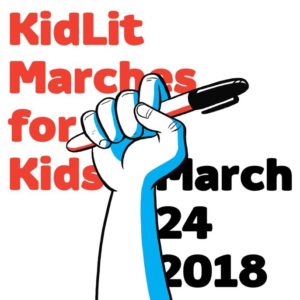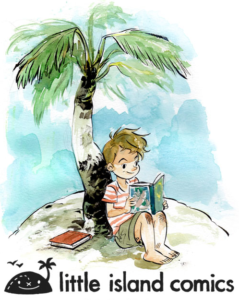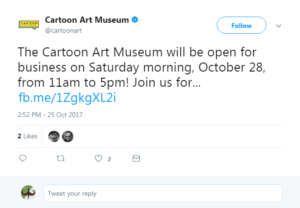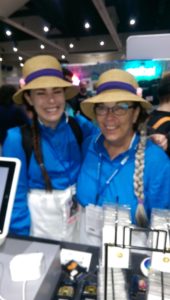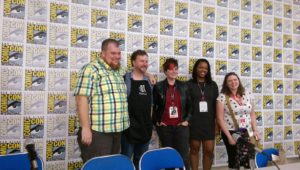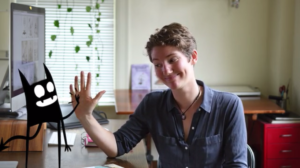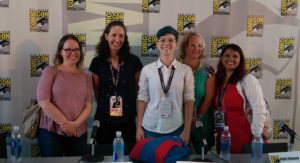
The parenthetical was Raina’s doing. When the pitch came to do a panel called Read Like A Girl: Middle-Grade Fiction For Girls, she wasn’t having any of the gendering of stories. Why is it that girls are expected to bea ble to read and enjoy books with boys as protagonists, but books with a girl in the lead are only for girls? She insisted that that title incorporate boys, and that the topic of the panel not be stories for girls.
Read Like A Girl: Middle-Grade Fiction For Girls (And Boys) took place in the Shiley Special Events Suite on the top floor of the San Diego Central Library; Brigid Alverson (of many, many things), my fellow pixel-stained wretch, was moderating.
Raina Telgemeier (queen of the fourth grade), Victoria Jamieson (Rollergirl, the forthcoming All’s Faire In Middle School), Molly Ostertag (Strong Female Protagonist, the forthcoming The Witch Boy), Nidhi Chanani (the forthcoming Pashmina), and Jenni Holm (Babymouse, Sunny) were the panel. The optics of having all women at the front of the room talking about girls reading was quickly and efficiently squashed — as Chanani put it later, It’s a book, it doesn’t have a gender.
[Editor’s note on presentation: italics like that last line represent as direct a quote as I was able to manage while transcribing in real time; plain text indicates that I am expressing the gist of what the speaker said, but it’s a paraphrase.)
But I’m getting a little ahead of myself; that discussion actually came up in the middle of the hour, but the all-genders inclusive nature of the panel was apparent from the beginning, so I’ve brought it forward. Let’s rewind to the start. Alverson opened by talking about growing up partially in the UK; the chief difference being that in the US, there were no comics for girls¹ but in the UK there were. Furthermore, all the best comics being done now are by (and if you have to assign a gender, for) women. So what did the panelists grow up reading?
Raina:² It was comic strips, all by dudes, then For Better Or For Worse leapt off the page and grabbed me.
Jamieson: Same as Raina; I didn’t read a comics as a kid, but I read a lot of books; I was missing realistic stories in comics, but I found those kinds of stories in prose. I read a lot of Ramona.
Ostertag: I didn’t know about comics other than strips, but I read so many books; the fantasy genre had a lot of female authors and characters that didn’t exist in comics. I felt like Superhero comics are not for girls, there’s not good female representation, I should not go there.
Chanani: It was all newspaper comics. The Garfield books were the most used books in the house.
Holm: I’m the middle of five kids, all the others are boys, so there were a lot of comics in our house. Dad had old collections of Flash Gordon, Prince Valiant, there were all the Peanuts collections. I also read a lot of classic superhero Marvel and DC; growing up house of all boys, I figured I could do everything they could do, but in comics there was no female equivalent of Peter Parker who had clothes on. I couldn’t find characters I could relate to.
Alverson: The others read newspaper strips, but Jenni you and I read comics.
Holm: The person I most related to was Swamp Thing: not a boy, not a girl, just a swamp.
Ostertag: Looking at comic books, I felt even as a kid it was not for me. It was all very male gazey and put me off wanting to be involved. It wasn’t aggressive, there was just nothing there for me.
Alverson then asked why the panelists are all making comics (when they had little good representation to tell them that they could), rather than writing prose.
Raina: I don’t know how to words. [laughter] I started making comics when I was ten; I started reading them at nine, then my fingers wouldn’t stop. I don’t know how to make stories without pictures. We didn’t have emoji when I was growing up, we had to find ways to express things in pictures.
Chanani: I’m not closed to writing prose sometimes, but comics works for what I want to make. I make art, I grew up reading prose, maybe I’ll do an illustrated book.
Holm: I think I’m the only one on the panel that can’t draw. I suckered my brother into drawing for me and that’s how you make comics. [laughter]
Jamieson: I’m here because of Raina; until I read Smile I never said yes this is something I could do, these are the stories I could tell. It gave me the permission to do things.
Raina: When I first saw your comics I wondered how have we not known each other our entire lives.
Ostertag: Comics are so wonderful to create; you can just flip it open and the heart of the story is there. When I got into it, I didn’t consider the industry, I just wanted to make them.
There was a great followup to Jamieson’s point at this time; the kinds of stories the panelists create didn’t exist for girls when they were each growing; they didn’t exist for boys until recently either.
Alverson: Raina, you’re kind of the prototype. How did you come up with Smile, what was your Smile?
Raina: For Better Or For Worse, BONE, Lynda Barry, the Optic Nerve comics by Adrian Tomine … all these different sources, but it led me to making something that was entirely me. I just knew I had this story, I needed to tell it, I’m a cartoonist, I’m doing this. I thought I was just going to run short stories on Girlamatic, but I decided to do a page a week and tell this longform story. I was telling a story about my dental work, but my readers were really interested in my friends, my relationship with my parents, and their interests really informed the direction of the story. The relationships are what make the kids relate to the story. I think all of us on the panel are writing about relationships.
Alverson: That’s something that did exist in prose, but not comics. All the good comics right now, the interesting ones, are by and for women. That raises the question in the title [Editor’s note — told you we’d get back to it], what about the boys? The cliche is that boys won’t read comics about girls, is that true?
Raina: There’s so much discrimination about what boys will read and what girls will read.
Jamieson: You asked where are the comics for boys, but they’re here. I have boys read the books, I know boys read the books, I go to school visits and they tell me they love them. Much like Calvin And Hobbes was about a boy but not for boys, I think our stuff is the same. Parents have the stereotype that you put a girl on the cover my son won’t read it but as soon as the kid gets their hands on it, they read it.
Chanani: It’s a book, it doesn’t have a gender, so why are we assigning a gender to something that doesn’t need it? Let the kids pick what they want to read. The gatekeepers have to step away, the kids don’t care.
Holm: Babymouse is very pink. What happened was we created Babymouse specifically for girls, but this was 2005, so we were boldly going for the girls, and our own prejudices assumed it was too much pink for the boys, but the boys do not care. I think sometimes the parents have problems, but I think Babymouse is pretty genderbendy; she sometimes sees herself as a boy mouse.
Ostertag: When I made [The Witch Boy], I made it about a boy wants to do what all the women in his family do: he wants to be a witch. I think girls have a lot of role models that tell them they can cross gender norms, be tomboyish, but I don’t think boys get to be more feminine, kind, emotionally aware. I think we need more books about sensitive boys and to destigmatize that.
Alverson: One of the things about children’s books is there are themes you see over and over again, but you each bring something different to it. There’s always a tension between the universal theme and what makes it specific. Can you talk about what sets your book apart?
Ostertag: It gets down the characters, who they end up being. I love to make stories with a point, then you develop it and the characters become more than somebody there to illustrate a point. It becomes a place you want to go and stay in.
Alverson: So basically making a really cool world.
Jamieson: That’s maybe where I start too. I was playing roller derby and loved it, wanted to share that. Same with the new book; I worked the Renaissance Faire in high school, and I wanted to create a world that readers would want to be in and never leave.
Raina: I do the exact opposite. It started with Oh braces, that sucks, but then kids know they suck and it becomes about finding ways to show kids they’re not alone.
Holm: I’m very nostalgic, and wanted to show the nostalgia for my 70s childhood, but also wanted to hang out with people I love. So the grandfather in Sunnys Side Up is based on my grandfather and the book is about having the best summer vacation hanging out in the retirement community in Florida with all old people. I’ve always been obsessed with that approach.
Chanani: I grew up with a variety of information and influences about India; I was born there, but came here when I was four months old. I wanted to put in all the ideas and history and culture of the India I wish I’d grown up in. Growing up here I internalized all those Feed The Children ads and everybody in them is malnourished and everything is terrible. In reality it’s all of those things, the good and bad. In the color pages I put all the things I love about India.
Alverson: Some of the books I loved when I was growing up, the Little House books for example, haven’t held up at all. How do you add a visual aspect to keep things universal, or do you care somebody will read this in 30 years and it’ll be dated?
Ostertag: I read very old books when I was a kid, things that were not contemporary, and they still resonated for me. Comics you can read quickly, but still go back and read for detail. I put a fidget spinner in my book and it’ll be dated before it’s out but I don’t care.
Raina: Kids don’t write, adults do. The book is already a generation or two removed from the reader. The feelings people have don’t change over generations. As far as the look of a graphic novel, will the look be dated, well, I’m writing memoir, and this is what it was like.
Jamieson: Hopefully, that won’t distract them too much, the truth of the characters will be what they focus on.
Ostertag: Kids read a lot of fantasy, and reading that they have to acclimate to a world that’s not what they grew up in. It’s the same for looking at things from another time.
Chanani: The idea that you can make something truly timeless is impossible, something will always stick out. Better to just focus on the characters.
Alverson: Lightning Round! What are you reading now that you really like for children?
Raina: Archie is like therapy.
Jamieson: Orphan Island by Laurel Snyder.
Ostertag: The Stars Beneath Our Feet by David Barclay Moore.
Chanani: Ghost by Jason Reynolds.
Holm: I’m totally inappropriate, I read romance.
Ostertag: Do you read a lot of things outside the genre? Me too.
Raina: Wolf In The Snow by Matthew Cordell.
Alverson: When I was a kid, books all came in series. When you look at your books, do you think about what the next book is going to be, do you want to move in a new direction, or do you want to stay with the characters for three books?
Chanani: The only thing that gets me through the art is that next book. Writing that next book in my head gets me through the painful moments of drawing. It’s a really nice escape, and gives me a lot of time to live with those characters.
Ostertag: I do an ongoing webcomic, so that’s a really long story, it’s going to take a long time to get to the end. Having a self-contained story in a book is a nice break for me.
Jamieson: I feel like when I’m writing a book I’m in it for twelve hours a day and when I’m done I have this awful empty void in me. It’s really hard to move on to the next book. I’m reticent to do sequels right away, but maybe in the future.
Raina: People just immediately wanted Smile 2³, but I don’t have another braces story, then I realized what they wanted was the characters of me and family. I really can’t go past the age of 14, 15, 16, so it’s hard to go back to that period again and again and reiterate again.
From the floor: In your own lives, how do you try to flip the script and get out of the one note of gender cliche?
Ostertag: I try to be hyperaware of tropes; gender and fiction is something I’m really aware of, and I try to constantly examine why you choose to gender a character a certain way, then I flip it. The reader can’t expect that if a character is visually feminine they should act feminine. You can make a book where people come away with a more nuanced view of gender.
Chanani: I was committed to making all these strong women in my book, I did all this pre-writing that won’t make it into the book, all their backstories, all this detail. But what I failed to do was to write anything about the men in the book and my editor said it might be nice if one of them was kind of nice and had something to balance their flaws. Because I absorbed so many one-dimesional characters that were women and I was fighting that, I had to be told I was doing that to the men.
From the floor: Do you have any advice about helping students create their own things that resonate with them? Any really vivid spark moments ?
Holm: I think kids are very visual now. Writers get writers block, so what I’ve started to do is look at my kids and their book reports, and I say let’s doodle it out, anything you want, just stick figures, sit with that for a little bit. When you can visually see the beginning, middle, and end, it helps you write and takes some of the pressure off from where they want every word to be perfect. Just give them scrap paper.
Ostertag: I started with a message and moral, scenes and settings I wanted to draw, then built the story around that. There’s an incredible amount of creativity in fanfiction, you can find inspiration anywhere.
Jamieson: As an exercise in schools, we sent a two minute timer and I wrote I REMEMBER at the top of a sheet of paper, and they just call out anything. After a couple of those, you have ideas you can start.
Raina: I do the same thing, prompt them with WHAT’S THE WEIRDEST THING THAT EVER HAPPENED TO YOU?
From the floor: When you set out to write these books are they geared to middle grades? When you write them is that the intent or getting the story out and then seeing if it fits?
Jamieson: It’s easy for me because I have a four year old and an eleven year old. I can think as an eleven year old, how I was as an eleven year old.
Holm: Don’t worry about the words, just write it, they can look it up. There’s this thing called a dictionary.
[Editor’s note: Like I said when listing out the panels for the show there was a lot of smart in this room. Oh, and because it would have taken too long to put the entire context in, you get one completely contextless quote from Jenni Holm that brought the room down: I think it’s strep, maybe!]
________________
¹ Alverson and I are not that far apart in age; had she been of reading age a decade earlier, she would have found comics aimed at girls. Remember that folks like Kirby did romance comics until they started dying off and thus he had to reinvent the superhero genre to keep working.
² And a reminder about the Fleen Manual Of Style: when referred to by one name, Raina Telgemeier is styled Raina, not Telgemeier.
³ Smile 2: Smile Harder?
